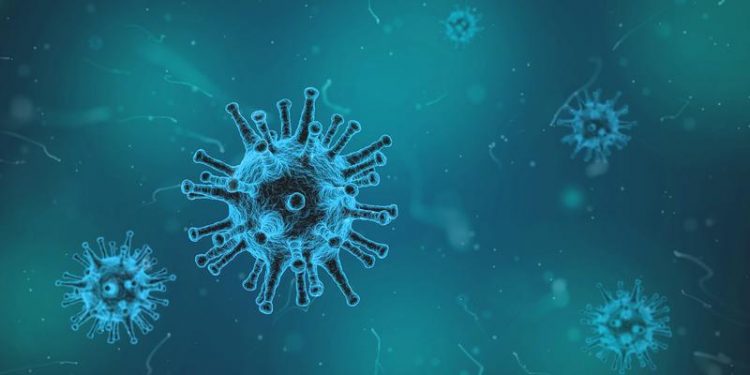A new piece in the puzzle of how herpesviruses outwit the immune system

Illustration of virus particles. © Pixabay
Humans are constantly exposed to pathogens like bacteria and viruses. In most cases, the immune system successfully detects and eliminates these invaders. However, the herpesvirus family has adapted brilliantly to the immune system: its members manage to stay in the host’s body for life after infection.
A research team at the Helmholtz Centre for Infection Research (HZI) recently discovered that a protein of the carcinogenic Kaposi’s sarcoma-associated herpesvirus (KSHV) commandeers an immune system component for its own benefit. This enables the virus to successfully infect its host. The researchers have published their results in the peer-reviewed journal PLOS Pathogens.
During his or her lifetime, every human being is infected with at least one of the nine human herpesviruses. In most cases, the immune system of healthy people keeps the infection under control and severe illness only rarely develops. Herpesviruses have adapted excellently to their host – they manipulate the immune system in many different ways and manage to remain in the host for life. If the immune system is weakened, herpesviruses can replicate and cause serious complications, including cancer.
Kaposi’s sarcoma-associated herpesvirus (KSHV) is a member of the human herpesvirus family. KSHV can cause three different forms of cancer: Kaposi’s sarcoma, primary effusion lymphoma, and multicentric Castleman’s disease, affecting blood vessels, white blood cells, and lymph nodes, respectively. Kaposi’s sarcoma occurs frequently in AIDS patients whose immune systems are severely weakened by infection with human immunodeficiency virus 1 (HIV-1).
So far, no vaccine against KSHV exists. The mechanisms used by this virus to manipulate its host and that lead to the development of cancer are also not fully understood. “To be able to successfully treat infections with this herpesvirus, we need to understand in detail how it controls our immune system”, says Prof Melanie Brinkmann, who leads the research group “Viral Immune Modulation” at the Helmholtz Centre for Infection Research (HZI) in Braunschweig, Germany and is a professor at the Hannover Medical School (MHH).
To gain insight into how KSHV escapes immune control, the Brinkmann research group has investigated a poorly understood protein of this virus, the protein ORF20. With mass spectrometric analysis, the researchers found that ORF20 forms a complex with a host protein of the innate immune defence system. “Normally, this host protein, known as OASL, is used to defend the host and has an antiviral function,” says Dr Kendra Bussey, a scientist in Brinkmann’s team and lead author of the study.
“However, we have now shown for the first time that OASL has a proviral function during KSHV infection – the presence of OASL favours progression of the infection, rather than stopping it.” Using genetically modified viruses, the scientists were able to show that OASL only has a proviral effect if the viral protein ORF20 is present. “This shows that KSHV can skillfully manipulate the host for its own benefit, beating the host with its own weapon, so to speak”, says Bussey.
Melanie Brinkmann and her team have carried out this research within the framework of a collaborative research centre (CRC900) funded by the German Research Foundation (DFG). In the future, in collaboration with researchers from the HZI and the MHH, they hope to gain further understanding regarding the cellular immune system control levers manipulated by KSHV to circumvent defences of the immune system. “This will provide us with new insights into the interaction between the virus and its host, and hopefully enable us to understand how this virus contributes to the development of cancer by manipulating the immune response”, says Brinkmann.
Original publication:
Kendra A. Bussey, Ulrike Lau, Sophie Schumann, Antonio Gallo, Lisa Osbelt, Markus Stempel, Christine Arnold, Josef Wissing, Hans Henrik Gad, Rune Hartmann, Wolfram Brune, Lothar Jänsch, Adrian Whitehouse, Melanie M. Brinkmann: The interferon-stimulated gene product oligoadenylate synthetase-like protein enhances replication of Kaposi's sarcoma-associated herpesvirus (KSHV) and interacts with the KSHV ORF20 protein. PLOS Pathogens, 2018, DOI: 10.1371/journal.ppat.1006937
The press release and a picture are also available on our website: https://www.helmholtz-hzi.de/en/news_events/news/view/article/complete/a_new_pie…
Helmholtz Centre for Infection Research:
Scientists at the Helmholtz Centre for Infection Research (HZI) in Braunschweig, Germany, are engaged in the study of different mechanisms of infection and of the body’s response to infection. Helping to improve the scientific community’s understanding of a given bacterium’s or virus’ pathogenicity is key to developing effective new treatments and vaccines. The HZI is a member of the German Center for Infection Research (DZIF). http://www.helmholtz-hzi.de/en
Contact:
Susanne Thiele, Press Officer
susanne.thiele@helmholtz-hzi.de
Dr Andreas Fischer, Editor
andreas.fischer@helmholtz-hzi.de
Helmholtz Centre for Infection Research
Press and Communications
Inhoffenstr. 7
D-38124 Braunschweig
Germany
Phone: +49 531 6181-1404
Media Contact
All latest news from the category: Life Sciences and Chemistry
Articles and reports from the Life Sciences and chemistry area deal with applied and basic research into modern biology, chemistry and human medicine.
Valuable information can be found on a range of life sciences fields including bacteriology, biochemistry, bionics, bioinformatics, biophysics, biotechnology, genetics, geobotany, human biology, marine biology, microbiology, molecular biology, cellular biology, zoology, bioinorganic chemistry, microchemistry and environmental chemistry.
Newest articles

Machine learning algorithm reveals long-theorized glass phase in crystal
Scientists have found evidence of an elusive, glassy phase of matter that emerges when a crystal’s perfect internal pattern is disrupted. X-ray technology and machine learning converge to shed light…

Mapping plant functional diversity from space
HKU ecologists revolutionize ecosystem monitoring with novel field-satellite integration. An international team of researchers, led by Professor Jin WU from the School of Biological Sciences at The University of Hong…

Inverters with constant full load capability
…enable an increase in the performance of electric drives. Overheating components significantly limit the performance of drivetrains in electric vehicles. Inverters in particular are subject to a high thermal load,…





















